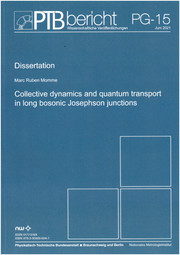Collective dynamics and quantum transport in long bosonic Josephson junctions von Marc Ruben Momme
Collective dynamics and quantum transport in long bosonic Josephson junctions
PTB-Berichte. Physikalische Grundlagen (PG) 15
ISBN/EAN: 9783956066047
Sprache: Englisch
Umfang: 130 S., 47 farbige Illustr., 47 Illustr.
Einband: kartoniertes Buch
Erschienen am
16.09.2021
Auf Wunschliste
In this thesis, the dynamics of two coupled elongated Bose-Einstein condensates are studied. The condensates rest in a double-well potential, whereby one dimension parallel to the barrier is extended. One can imagine two cigar-shaped condensates, which are coupled along their long axis. Such a system forms a long bosonic Josephson junction. The study is performed within the theoretical framework of the Gross-Pitaevskii equation and the Bodoliubov-de Gennes formalism. The spectrum of low-energy collective excitations is analyzed as well as its influence on the population dynamics between the wells. This analysis generalizes the standard bosonic Josephson equation approach. One finds that the collective excitations lead to multiple-frequency oscillations of the two atomic populations. To develop a better understanding of the collective excitations, a one-dimensional model of coupled condensates is developed, which is capable of reproducing the excitation spectrum and population dynamics of the system. For a system of two coupled infinite and uniform condensates, the model becomes analytically solvable. The predicted spectrum and dispersion of the collective excitations (or Bogoliubov quasiparticles) are compared to a numerical simulation of the realistic case of a trapped system. The comparison reveals a reasonable agreement, however it also shows the existence of several anomalous Bogoliubov modes in the spectrum. These modes show degeneracy in both energy and momentum together with self-localization in coordinate space. Finally, the regime of high initial population imbalances is investigated. The bosonic Josephson equations predict a regime of self-trapped population oscillations, which cannot reach the state of equally populated wells. The numerical simulations show regions of stable selftrapping and unstable decay of the population oscillations. The decay mechanism was investigated for one particular case. The analysis shows that a Bogoliubov mode develops in the condensate with lower population that builds up until it interferes with the oscillations of the selftrapped state, at which point the decay starts.






